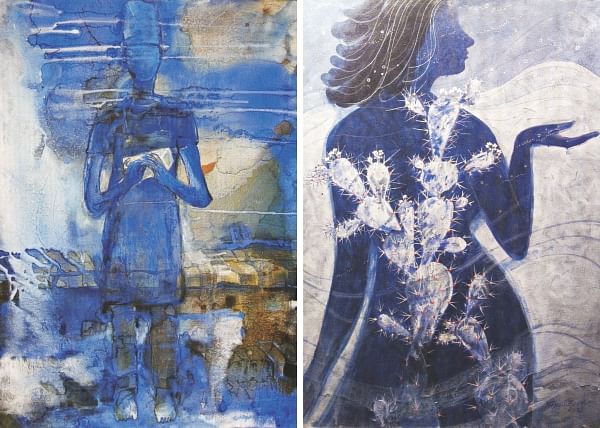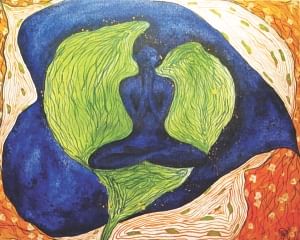| Home - Back Issues - The Team - Contact Us |
 |
| Volume 11 |Issue 46| November 23, 2012 | |
|
|
Art SHAKO Celebrates its 10th Anniversary with a Picasso Workshop Shades and Faces of Blue Fayza Haq
The women painters of SHAKO, who participated in the recent art camp at Athena, located in Uttar Badda, dwelt on Picasso's Blue Period for its theme under the guidance of Rowshan Morshed, Zeenat Ikramullah and Asif Rizwanali. “Picasso's Blue Period limits the theme of the painter," says Dr Farida Zaman, a professor and social worker. "However, it opens up the imagination. I wanted to use the blue in the context of Bangladeshi women. I was forced to use them as a guide. If I wanted to imitate Picasso, I could have concentrated on many social limitations that restrict our women on a daily basis, but my natural instinct as an artist steered me away which highlight the enduring female spirit. Art camps foster spontaneity—where a single dot or a single line applied during the moment of inspiration must be infused with the larger work." Fresh from her studies in the US and her visit to Australia, Rokeya Sultana says, "Woman, mother and wife—I am all those things. My heart is filled with pride and love when I reflect on the many different roles that a woman plays in society. There is an extreme diversity of women's role in our motherland; and it would be unfair to describe them under similar categories. Picasso wanted to share his sadness about his friend's suicide, and used the colour blue to symbolise his depression and pain. I wanted my paintings to represent the underprivileged and neglected. Naima Haq says; "The Blue stands for aristocracy, white stands for purity and red for war. The cross-hatch lines suggest an ever present and determined source of conspiracy working to create disharmony, among all different worshippers of the world. While Picassso concentrated on social problems, he witnessed around him, I, on the other hand, am choosing to see the global crisis of dignity and peace." Kuhu Plamondon, the well- known fashion designer and artist of woman's figures says, "Picasso's Blue period was a time in which the artist shared the sadness in his life through his artwork. I believe that my infusion of colours create a brighter and luminous setting. I have combined and contrasted the blue with orange, and have thus shown the different side of blue, which is not my favourite colour."
Rokeya Sultana's “Catch of the day” has beautifully rounded fish with a colourful setting of navy blue, vermilion and white. Her “Blue Baker”acrylic on canvas is equally invigorating. Naima Haque's “Red and Blue” – Acrylic on canvas– has symbols of various religions, such as stars of Bethlehem, a cross in blue, an emaciated seated Buddha. Dr Farida Zaman's “Blue Lagoon” has fish done in gray and orange with a backdrop of dark blue and pale gray. Characteristic of Nasreen's work, "Woman with Cactus" in the two versions has shapely women with cactus, seen against waves of gray and blue. “Athena carried the logistics to have a successful workshop,” says Nasreen Begum. "Blue is hopeful for me as opposed to Picasso's tone of despair. Nature has chosen the colour blue to show the enormity of the sky, and the mysteries of the deep ocean. I have used the deep layers of blue to represent the many human emotions of love, longing and loneliness." Fareeha Zeba remarks that the workshop at Athena gave the artists a chance to freely interact, collaborate and exchange ideas with each other, especially with the younger artists. "Through SHAKO, which means connection, senior and junior artists work from one platform," adds Kanak Chanpa Chakma, "Our aim is to contribute to society, and stimulate awareness regarding important, social issues. The art camp allowed me to shed light on the unfortunate hostility and violence aimed at the Buddhists and their temples in Ramu." Farzana Islam Milky sums up the philosophy behind such workshops: “The interesting aspect of the exhibition is to go beyond Picasso's perspective of melancholia. I am mainly a sculptor, and do not paint. Yet I enjoy exploring my painting skills with my peers.”
|
||||||||||||
|
|||||||||||||


